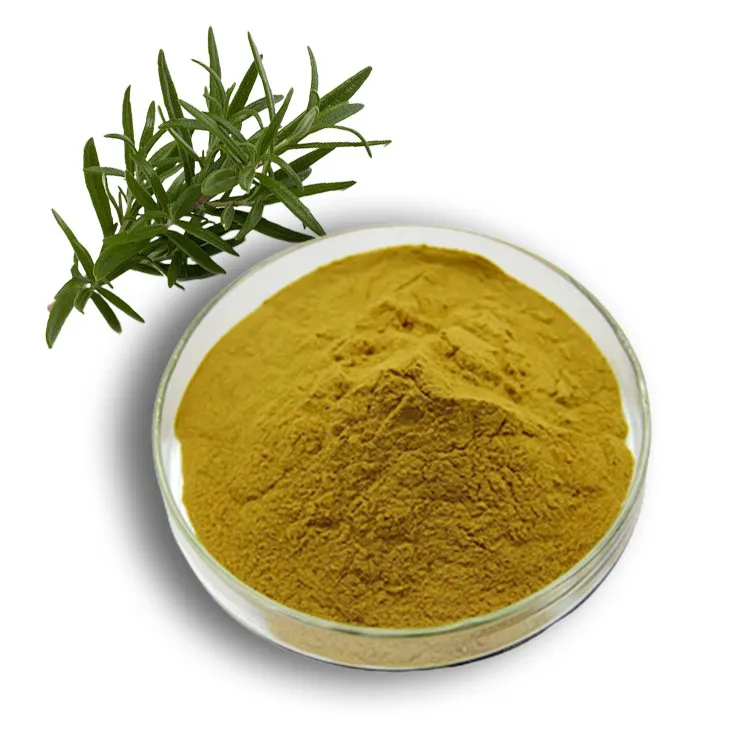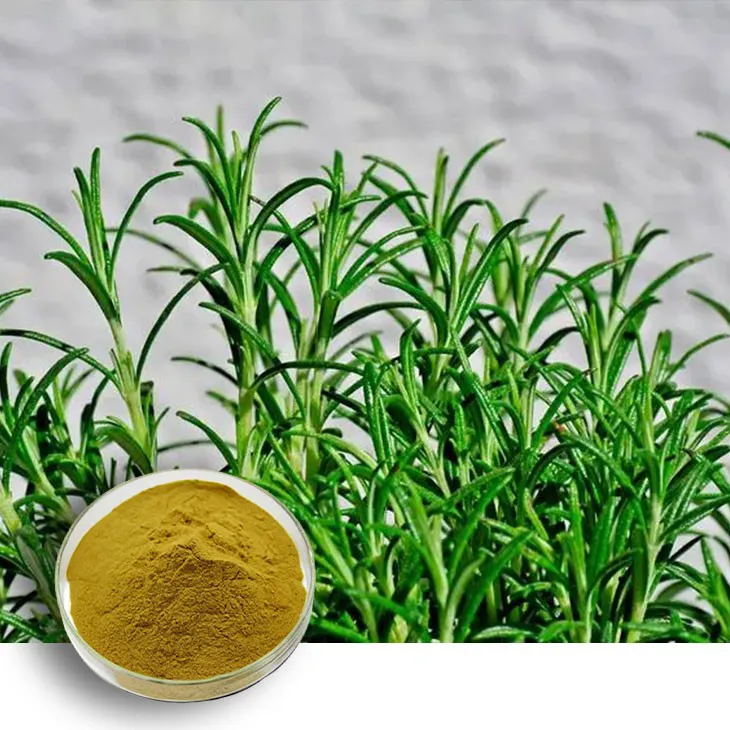- 0086-571-85302990
- sales@greenskybio.com
The process of extracting rosmarinic acid from rosemary extract.
2024-11-26

1. Introduction
Rosemary (Rosmarinus officinalis) is a well - known aromatic herb that has been used for centuries in cooking, traditional medicine, and cosmetics. Rosemary extract contains a variety of bioactive compounds, among which rosmarinic acid stands out due to its numerous potential health benefits. Rosmarinic acid is a phenolic compound with antioxidant, anti - inflammatory, antimicrobial, and antiviral properties. As a result, there is a growing interest in efficiently extracting rosmarinic acid from Rosemary extract for use in pharmaceuticals, nutraceuticals, and cosmeceuticals.

2. Chemical Properties of Rosmarinic Acid
2.1 Structure
Rosmarinic acid has a complex chemical structure. It is an ester of caffeic acid and 3,4 - dihydroxyphenyllactic acid. Its molecular formula is C₁₈H₁₆O₈. The presence of phenolic hydroxyl groups in its structure is crucial as it imparts antioxidant properties. These hydroxyl groups can donate hydrogen atoms to free radicals, thereby neutralizing them and preventing oxidative damage.2.2 Solubility
The solubility of rosmarinic acid plays a significant role in determining the extraction methods. It is soluble in polar solvents such as water, methanol, and ethanol. However, its solubility in non - polar solvents is relatively low. This solubility characteristic is related to its polar functional groups, which can form hydrogen bonds with polar solvent molecules. For example, in water, the phenolic hydroxyl groups of rosmarinic acid can interact with water molecules through hydrogen bonding, facilitating its dissolution.
3. Extraction Methods
3.1 Supercritical Fluid Extraction (SFE)
- Principle: Supercritical fluid extraction utilizes a supercritical fluid, typically carbon dioxide (CO₂), as the extraction solvent. A supercritical fluid has properties between those of a liquid and a gas. CO₂ is often chosen because it is non - toxic, non - flammable, and has a relatively low critical temperature (31.1°C) and pressure (73.8 bar). At supercritical conditions, CO₂ has a high diffusivity and low viscosity, which allows it to penetrate into the plant matrix effectively and extract the target compound, in this case, rosmarinic acid.
- Procedure: The rosemary plant material is placed in an extraction vessel. Supercritical CO₂ is then pumped into the vessel at the appropriate temperature and pressure. The rosmarinic acid dissolves in the supercritical CO₂. After extraction, the pressure is reduced, causing the CO₂ to return to a gaseous state, leaving the rosmarinic acid behind. This process can be optimized by adjusting parameters such as temperature, pressure, and extraction time.
- Advantages: SFE is a clean and green extraction method. It does not leave behind toxic solvent residues, which is crucial for applications in the food and pharmaceutical industries. It also has a relatively short extraction time and can be highly selective, resulting in a high - purity extract.
- Disadvantages: The equipment for supercritical fluid extraction is expensive, which may limit its widespread use. Additionally, the extraction efficiency may be affected by factors such as the particle size of the rosemary material and the complexity of the plant matrix.
3.2 Solvent - Based Extraction
- Principle: Solvent - based extraction relies on the solubility of rosmarinic acid in polar solvents. Common solvents used include methanol, ethanol, and water. The solvent penetrates the rosemary tissue, dissolves the rosmarinic acid, and then the solution containing the compound is separated from the plant material.
- Procedure:
- First, the rosemary material is ground into a fine powder to increase the surface area available for extraction.
- The powdered rosemary is then mixed with the selected solvent in an appropriate ratio. For example, a common ratio could be 1:10 (w/v) of rosemary powder to solvent.
- The mixture is stirred or shaken for a certain period, usually several hours to overnight, at a controlled temperature. This helps in maximizing the dissolution of rosmarinic acid into the solvent.
- After extraction, the mixture is filtered to separate the liquid extract (containing rosmarinic acid) from the solid plant residue.
- Advantages: Solvent - based extraction is relatively simple and inexpensive compared to SFE. It can be carried out in a standard laboratory setting with basic equipment. Ethanol - based extraction, in particular, is often preferred in the food and pharmaceutical industries due to its safety and availability.
- Disadvantages: One major drawback is the potential presence of solvent residues in the final extract. These residues may need to be removed through additional purification steps, which can increase the overall cost and processing time. Also, solvent - based extraction may extract other unwanted compounds along with rosmarinic acid, reducing the purity of the final product.

4. Comparison of Extraction Efficiencies
The efficiency of rosmarinic acid extraction depends on various factors for both supercritical fluid extraction and solvent - based extraction.
- For SFE, as mentioned earlier, parameters like temperature, pressure, and extraction time play a crucial role. Higher pressures generally lead to increased extraction efficiency, but there is a limit beyond which further increases may not be cost - effective. Similarly, the optimal temperature needs to be determined based on the solubility characteristics of rosmarinic acid in supercritical CO₂. In general, extraction efficiencies in SFE can range from 50% - 90% depending on these parameters and the quality of the rosemary material.
- In solvent - based extraction, the choice of solvent, solvent - to - sample ratio, extraction time, and temperature also influence the efficiency. Methanol - based extraction often shows higher extraction efficiencies compared to ethanol - based extraction in some cases, but ethanol is more widely acceptable in certain industries. Extraction efficiencies in solvent - based extraction typically range from 40% - 80%.

5. Purification Steps after Extraction
5.1 Filtration
After extraction, whether by SFE or solvent - based extraction, the first step in purification is often filtration. Filtration is used to remove any solid particles such as plant debris or undissolved material from the extract. This can be achieved using filter papers, membranes, or filter cartridges. For example, in solvent - based extraction, after the extraction mixture is stirred and allowed to settle, the liquid extract can be filtered through a Whatman filter paper to obtain a relatively clear solution.5.2 Evaporation
Evaporation is another important purification step. In solvent - based extraction, the solvent needs to be removed to obtain the rosmarinic acid in a more concentrated form. This can be done by using rotary evaporators. The solvent is evaporated under reduced pressure and controlled temperature. However, care must be taken not to overheat the extract as rosmarinic acid may be degraded at high temperatures. In SFE, since the supercritical fluid (CO₂) is removed by depressurization, this step may not be as crucial in the same sense as in solvent - based extraction.5.3 Chromatographic Purification
Chromatographic techniques such as high - performance liquid chromatography (HPLC) or column chromatography can be used for further purification. HPLC is a highly effective method for separating rosmarinic acid from other impurities. In HPLC, the extract is injected into a column filled with a stationary phase, and a mobile phase is pumped through the column at a controlled flow rate. Rosmarinic acid and other components in the extract interact differently with the stationary and mobile phases, resulting in their separation. Column chromatography, on the other hand, uses a column packed with a solid adsorbent material. The extract is loaded onto the column, and different components are eluted at different times by using an appropriate eluent. This helps in obtaining a highly purified rosmarinic acid sample.6. Potential Applications of High - Quality Rosmarinic Acid
6.1 Pharmaceuticals
Due to its antioxidant and anti - inflammatory properties, rosmarinic acid has potential applications in the pharmaceutical industry. It may be used in the development of drugs for treating inflammatory diseases such as arthritis. Rosmarinic acid can inhibit the production of pro - inflammatory cytokines, thereby reducing inflammation. It may also be explored for its potential in protecting against neurodegenerative diseases like Alzheimer's, as antioxidants can help in reducing oxidative stress in the brain.6.2 Nutraceuticals
In the nutraceuticals field, rosmarinic acid can be added to dietary supplements. It can act as a natural antioxidant, protecting the body against free radical damage. For example, it may be included in supplements targeted at promoting heart health or improving skin health. Consumers are increasingly interested in natural alternatives to synthetic antioxidants, and rosmarinic acid fits this demand.6.3 Cosmeceuticals
Rosmarinic acid has applications in cosmeceuticals as well. Its antioxidant and anti - inflammatory properties make it suitable for use in skincare products. It can be added to creams, lotions, and serums to help in reducing skin inflammation, preventing skin aging caused by oxidative stress, and improving skin complexion.7. Conclusion
The extraction of rosmarinic acid from Rosemary extract is a complex process that is influenced by the chemical properties of rosmarinic acid. Both supercritical fluid extraction and solvent - based extraction methods have their own advantages and disadvantages in terms of extraction efficiency, cost, and purity. Purification steps after extraction are essential to obtain high - quality rosmarinic acid. The high - quality rosmarinic acid obtained has great potential in pharmaceuticals, nutraceuticals, and cosmeceuticals. Future research may focus on further optimizing extraction and purification processes to meet the increasing demand for rosmarinic acid - based products.
FAQ:
1. What are the main chemical properties of rosmarinic acid that affect its extraction?
Rosmarinic acid is a phenolic compound. Its polarity and solubility characteristics are important chemical properties affecting extraction. It has polar groups which can interact with polar solvents. For example, its phenolic hydroxyl groups can form hydrogen bonds with solvents like water or alcohols in solvent - based extraction methods. Also, its molecular size and structure can influence the efficiency of extraction techniques such as supercritical fluid extraction. The relatively large and complex structure may require specific conditions in extraction processes to ensure efficient separation from the rosemary extract.
2. How does supercritical fluid extraction work for rosmarinic acid extraction?
Supercritical fluid extraction uses a supercritical fluid, often carbon dioxide. In the supercritical state, carbon dioxide has properties between a gas and a liquid. For rosmarinic acid extraction, the supercritical carbon dioxide can penetrate the matrix of the rosemary extract. It can dissolve rosmarinic acid based on its solubility characteristics. The extraction is typically carried out under specific pressure and temperature conditions. By adjusting these parameters, the solubility of rosmarinic acid in the supercritical fluid can be optimized. After extraction, the supercritical fluid is depressurized, and the rosmarinic acid is recovered.
3. What are the advantages and disadvantages of solvent - based extraction for rosmarinic acid?
Advantages of solvent - based extraction include simplicity and relatively low cost. Commonly used solvents such as ethanol or methanol can effectively dissolve rosmarinic acid from the rosemary extract. However, there are also disadvantages. One is the potential toxicity of solvents, which requires careful removal during purification steps. Also, solvent - based extraction may extract other unwanted components along with rosmarinic acid, leading to a less pure product compared to some other extraction methods.
4. What are the purification steps after extracting rosmarinic acid?
After extraction, purification steps may include filtration to remove solid impurities. Chromatographic techniques can also be used. For example, column chromatography can separate rosmarinic acid from other co - extracted substances based on differences in their affinities for the stationary and mobile phases. Another possible step is crystallization, where the conditions are adjusted to allow rosmarinic acid to form pure crystals while impurities remain in solution.
5. What are the potential applications of high - quality rosmarinic acid?
High - quality rosmarinic acid has various potential applications. In the pharmaceutical industry, it may have antioxidant, anti - inflammatory, and antimicrobial properties, which could be useful for developing drugs. In the food industry, it can be used as a natural preservative due to its antioxidant activity. It may also find applications in the cosmetic industry as an ingredient in skincare products for its antioxidant and anti - inflammatory effects on the skin.
Related literature
- Extraction and Characterization of Rosmarinic Acid from Rosemary: A Review"
- "Optimization of Rosmarinic Acid Extraction from Rosemary Using Supercritical Fluid Extraction"
- "Solvent - based Extraction of Rosmarinic Acid: A Comparative Study"
- ▶ Hesperidin
- ▶ citrus bioflavonoids
- ▶ plant extract
- ▶ lycopene
- ▶ Diosmin
- ▶ Grape seed extract
- ▶ Sea buckthorn Juice Powder
- ▶ Beetroot powder
- ▶ Hops Extract
- ▶ Artichoke Extract
- ▶ Reishi mushroom extract
- ▶ Astaxanthin
- ▶ Green Tea Extract
- ▶ Curcumin Extract
- ▶ Horse Chestnut Extract
- ▶ Other Problems
- ▶ Boswellia Serrata Extract
- ▶ Resveratrol Extract
- ▶ Marigold Extract
- ▶ Grape Leaf Extract
- ▶ blog3
- ▶ blog4
-
Chinese Rhodiola Root Extract Suppliers.
2024-11-26
-
100% Pure Natural Goldenseal Extract.
2024-11-26
-
Tamarind extract powder
2024-11-26
-
Sea buckthorn oil
2024-11-26
-
Lavender Extract
2024-11-26
-
Red Vine Extract
2024-11-26
-
Hedyotis Diffusa Extract
2024-11-26
-
Oat Straw Extract Powder
2024-11-26
-
Saw Palmetto Extract
2024-11-26
-
Bamboo Leaf extract
2024-11-26
-
Nettle leaf extract
2024-11-26
-
Ginseng Root Extract
2024-11-26





















